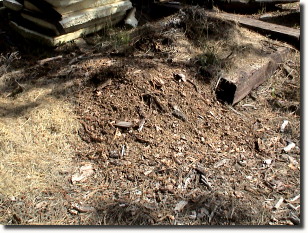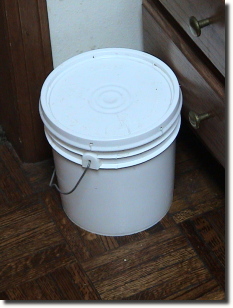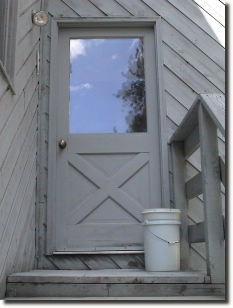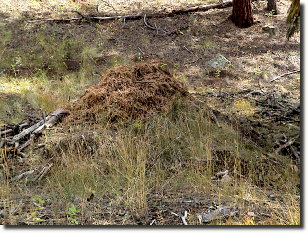
While we high altitude gardeners do not have as much organic matter to compost as lower altitude gardeners, it still is possible to have that nice, rich, black compost that is so good for plants.

This is my current compost pile. It is by our side road where we also pile other "stuff" and have our woodpile. The four sides are delineated by 4 foot railroad ties. This is not the greatest compost pile I've ever had but it does ok.
This pile is composed of vegetable scrapes from my kitchen and grass clipping from my once a year cutting around our house. I occasionally have weeds and other plants that I've taken out of my gardens but weeds don't grow too readily up here. Right now, the back of the pile is the kitchen scrapes covered with grass clippings, the middle part is sawdust from cutting up firewood (great for mulching), and more grass clippings from another year.


I use a two stage method for collecting my kitchen wastes. I have an indoor pail, pictured in the first image. This is a gallon bucket with a good sealing lid - necessary so gnats don't gather in there. As I cook and create vegetable scraps (potato peelings, apple peels and cores, coffee grounds, etc.), I put them in this small pail. Prior to getting this small pail from my good neighbor, I used a large tupperware container or a very large plastic container from something like yogurt, always making sure the container had a tight fitting lid.
Right by our back door, shown in the second image, I keep a 5 gallon pail, again with a tight-fitting lid. When the indoor pail fills, I dump the contents into this pail. The lid keeps the critters out and I have never had problems with bears getting into this pail. When the outdoor pail fills, I empty it into my current compost pile. It takes a long time to fill this pail.
This two stage method has several advantages:
I can just put the vegetable scrapes into the indoor pail as needed, I don't have to carry them anywhere and I don't have to open the back door to dump them. This is especially advantageous in the winter when I don't want to let in -20°F air.
It takes a long time (6 months or so) for me to fill the outside pail which means that the vegetable scraps are pretty well composted before I dump the contents on my compost pile. Our weather is very dry here and I found keeping a compost pile wet enough to work was difficult, especially the matter that was on top.
When I was putting the kitchen vegetable directly into my compost pile, critters thought I was feeding them and quickly ate most of the scrapes. The critters cannot get into my outdoor pail and they don't eat the mostly decomposed scrapes when I dump the outdoor pail.

We have a second pile of composting vegetative matter. I wrote "we" because my dear husband has collected most of this matter. Every now and then, in midsummer, we have an enormous rain storm - my husband refers to them as a "toad strangler". We will get 6 to 10 inches or more rain in less than an hour. Our property drains a huge area through our west gulch and west meadow. As the rain runs down the steep slopes in this area, pine needles, pine cones, sticks, dirt, etc. wash into the lower gulches and wash down onto our property forming a fast flowing stream in our west meadow. Debris collects on the edge of the stream.
A day or two after the "toad strangler", my husband goes down into the meadow and, using a pitch fork, gathers up this debris and puts it into the back of our old truck. Then, he puts the debris on the meadow compost pile, shown in the above image. The meadow compost pile is large: about 5 feet high and 10 feet in diameter. If he were to leave the debris in the meadow, it would smother the grass and look pretty terrible.
This pile really composts quickly. However, when I dig out the compost, there are many sticks and cones that I have to remove. This takes a long time but the resulting compost is great for my gardens.
The top of the meadow compost pile is covered with pine needles in the image. We recently had to take down a pine beetle killed tree. When my husband cut down the tree, he had to fell it over our driveway. This resulted in a lot of pine needles strewn about. Normally, we leave the pine needles in the forest but, with winter coming, we needed to clear the driveway. So, the pine needles became part of this compost pile.
I do not have an image of my best compost piles. These were constructed of 4 or 5 straw bales arranged in a circle. I would put the vegetable scrapes in the center of the straw bales. The straw bales kept the pile very moist and this made the best compost.
After a couple of years, the straw bales began to rot also. I then began using the straw as mulch in my vegetable garden. Whenever I used fresh straw for mulch, I always had a problem with the straw seeds and other weed seeds germinating in my garden; all the seeds in the semi-rotted straw were destroyed and I didn't have the weed problem any more. As I used each straw bale for mulch, I replaced it with a new one.
Using the straw bales had another advantage: when I wanted to turn the compost pile or get some compost out, I had only to remove one or two bales and I had easy access to the rotting vegetable matter.
One year, during cooler weather, I noticed that a rocky mountain fox was hanging around my straw bale compost pile quite a bit. Since I knew he wasn't eating the rotting vegetables, I wondered why. It turned out that chipmunks and other rodents were living in the pile as the rotting vegetables were quite warm and toasty. That fox was no fool!